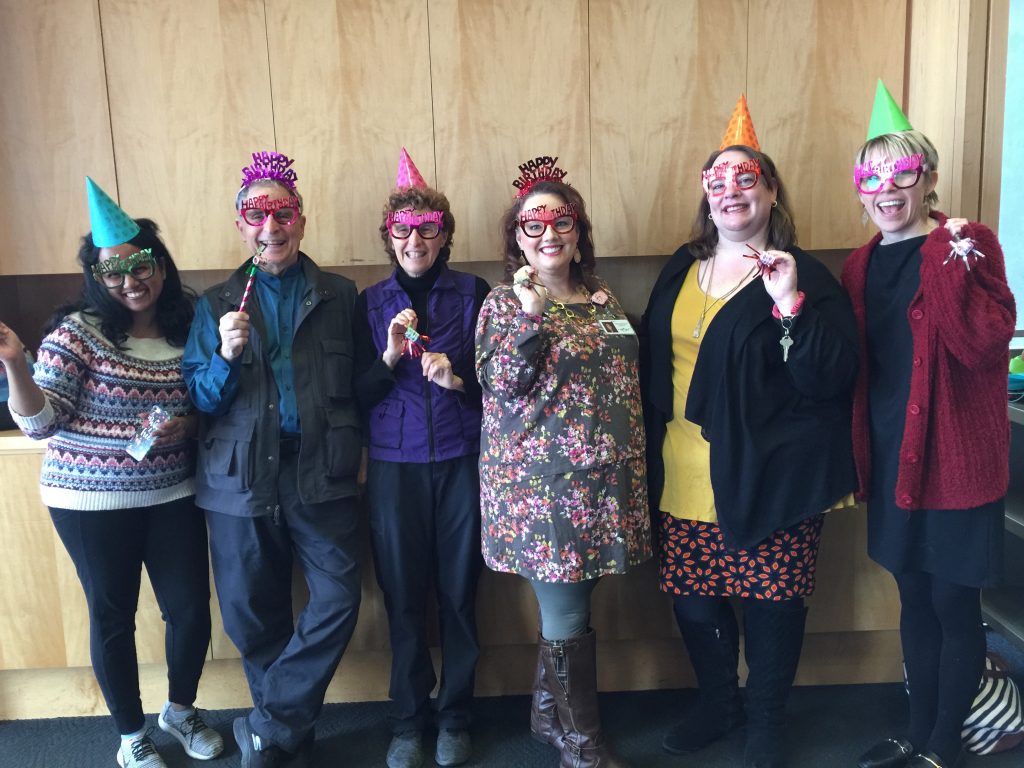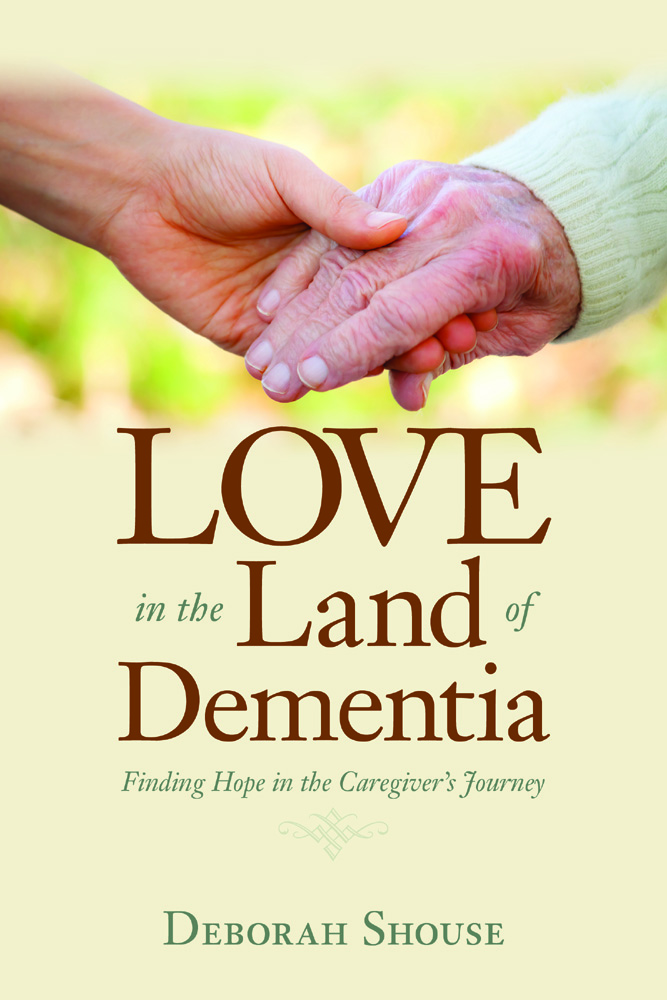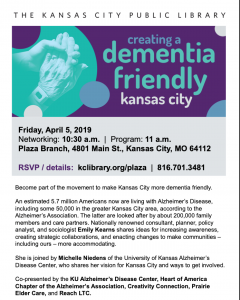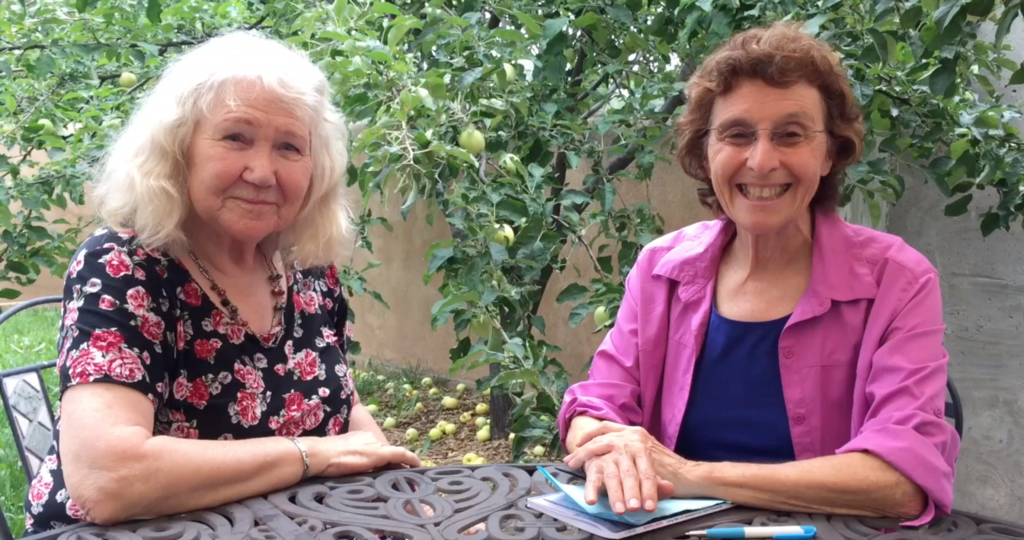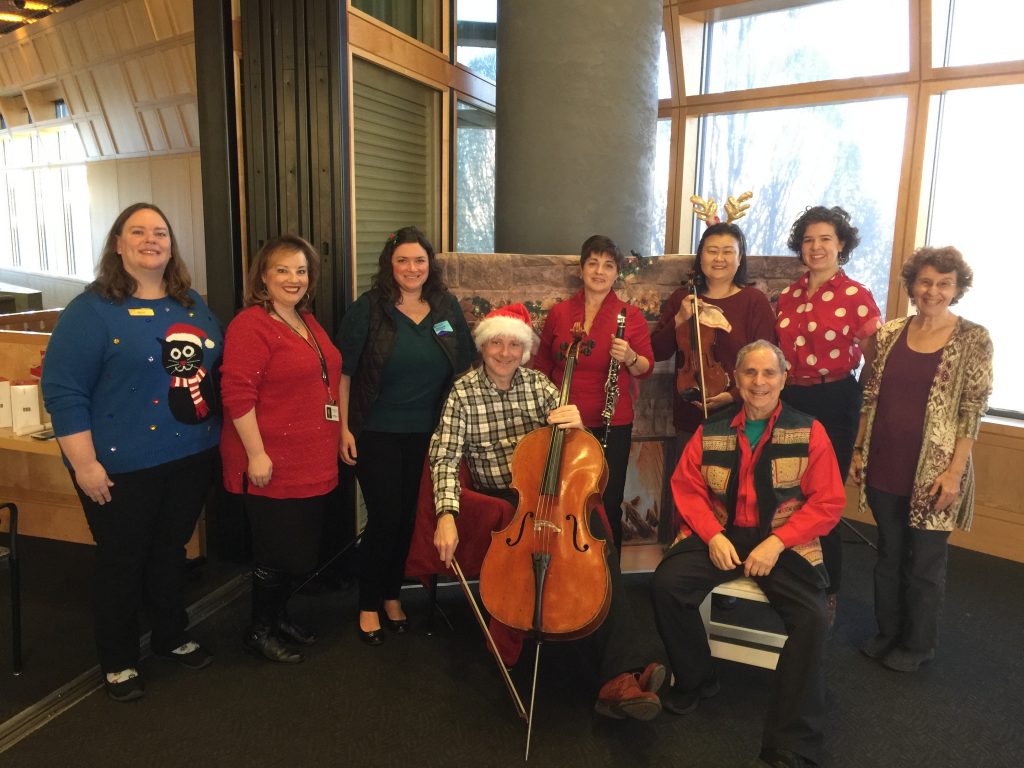Rock Around the Library: Celebrating a Year of KC Memory Cafes
No one can sit still. Not when Little Richard, The Archies, or Dion are singing. It’s a Rock Around the Library: Celebrating a Year of the KC Memory Cafes. We are one-year-old this March and we’re celebrating with Musical Bingo by Carrieoke Productions. We’ve enjoyed ice cream and cake and we’re ready to roll, rock and roll, that is.
At the first note, one of our guest says, “Sugar, Sugar.” She’s right and a small group of us sings the literally saccharine 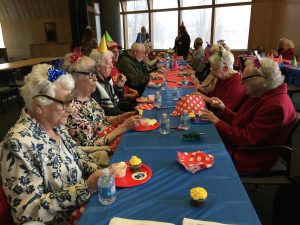 lyrics, “Sugar, ahh honey, honey, you are my candy girl…”
lyrics, “Sugar, ahh honey, honey, you are my candy girl…”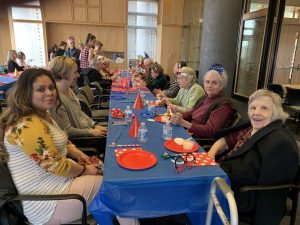
Within moments, all the care partners are dancing. We’re all helping each other find the songs on our Bingo sheets. We’re singing along when we know the lyrics and humming along when we don’t. We’re laughing.
When Carrie plays the Beach Boys’ tune, I Get Around, one guest says, “I wish I could get around.” Another chimes in, “Me too!”
For an hour, we Twist and Shout, warble Do You Want to Dance?, warn our neighbors not to “step on my Blue Suede Shoes,” and shake our heads over Run Around Sue. Those who win at musical bingo, and there are many of them, get to select a prize. 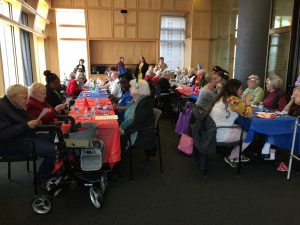
“It’s wonderful to see people blooming,” one care professional says.
And it’s equally wonderful to see the caregivers laughing, joking, dancing, encouraging, sharing, and helping us create This Magic Moment.
Click here to join the party:
Don’t miss our Magic Moment in April. The Kansas City Zoo is bringing some exotic and personable animals on April 16th.
Please join us at 10:30 on the lower level of the Plaza Library. Come early. Please share this information with anyone who might benefit.
Deborah Shouse is the author of Connecting in the Land of Dementia: Creative Activities to Explore Together and Love in the Land of Dementia: Finding Hope in the Caregiver’s Journey.
Creating a Dementia Friendly Kansas City: Join us and make a difference.
Quality Moments in the Land of Dementia: Laughing and Creativity in Jamaica
Our hosts started the program with a beautiful hymn of gratitude, a perfect way to acknowledge the spiritual aspects of connecting and laughing in the land of dementia. We met in the Salvation Army Church and Community Centre in historic downtown Falmouth, Jamaica, with a group of caregivers and community advocates. During our time together, we shared stories, information, laughter exercises, and creative ideas for taking care of ourselves and staying engaged.
 For many, this was an introduction to dementia. For others, who were in the midst of caregiving, this was a time of learning and sharing.
For many, this was an introduction to dementia. For others, who were in the midst of caregiving, this was a time of learning and sharing.
Ron and I talked about the importance of accepting each other as we are, no matter what we are going through. We discussed the power of having a purpose and how vital it is for all of us to have meaningful relationships and interesting experiences. .
”When communicating with people who are living with dementia, don’t argue,” Shirley Duncan reminded everyone. “Don’t criticize. Be there to support and appreciate.”
“When we are kind to ourselves, then we are better able to be kind to others,” one of our attendees said.
We discussed Dr. Cameron Camp’s concept of cognitive ramps, offering people the assistance they need 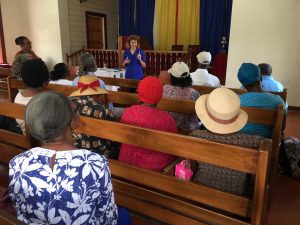 to remain engaged in the activities they love. Here’s one example from our session: Lorna’s mother was a professional cook, completely at home in the kitchen. As her dementia progressed, she could no longer remember the family’s favorite recipes. But she could sit in the kitchen and enjoy the energy of cooking. And when Lorna’s daughter said, “We are going to make your famous stew. Does it have an onion in it?” the mother smiled and nodded. Ingredient by ingredient, they consulted her, and she smiled and nodded at the mention of the right ingredients. Even though she wasn’t physically creating the meal, she was an integral part of the process.
to remain engaged in the activities they love. Here’s one example from our session: Lorna’s mother was a professional cook, completely at home in the kitchen. As her dementia progressed, she could no longer remember the family’s favorite recipes. But she could sit in the kitchen and enjoy the energy of cooking. And when Lorna’s daughter said, “We are going to make your famous stew. Does it have an onion in it?” the mother smiled and nodded. Ingredient by ingredient, they consulted her, and she smiled and nodded at the mention of the right ingredients. Even though she wasn’t physically creating the meal, she was an integral part of the process.
We talked about the power of music, sharing ideas from Dan Cohen’s Music and Memory program and introduced people to the personal playlist. We had an impromptu Conductorcise session, using Maestro David Dworkin’s aerobic and ground-breaking program, pretending we were conducting a symphony orchestra. We used laughter syllables to make it even more fun and soon everyone was standing up and conducting and laughing.
We shared a story from Karen Stobbe, reminding us all to affirm and appreciate and to use the improv technique, “Yes and…” to ignite and invite conversation.
Throughout our discussion, we wove in laughter exercises.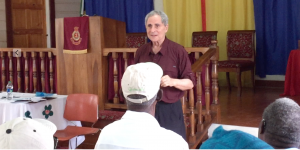
We enjoyed an imaginary laughter swim. We batted around laughter balloons and cooked up a laughter stew that included fish, pumpkin, garlic, carrots, Irish potatoes and okra.
At the end, we breathed in our gratitudes, closed our eyes and sent our feelings of love, connection, and laughter into the world, hopefully to help and inspire others.
Click here for a small taste of this lively workshop:
A special thanks for the dementia advocates and community volunteers who brought everything together, including Dundeen Ferguson, Shirley Duncan, Sandra Latibeaudiere, Elise Thomas, and Lorna Colley. And thanks to everyone who attended.
Deborah Shouse is the author of Connecting in the Land of Dementia: Creative Activities to Explore Together and Love in the Land of Dementia: Finding Hope in the Caregiver’s Journey.
Laughing for Health and Happiness in St. Thomas
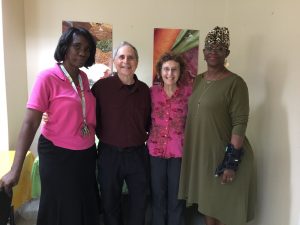 The people of St. Thomas have been through a lot and many are still recovering from Hurricane Maria. But despite the hardships, they were ready to laugh for health and happiness. We were delighted to be working with our friend Arleen Evans O’Reilly, Director of the Family Caregiver Support Program, offering a laughter yoga class in St. Thomas. We met at the senior center and had a wonderful time facilitating laughter with seniors, caregivers, and people who are living with dementia. CLICK HERE to experience a glimpse of our session.
The people of St. Thomas have been through a lot and many are still recovering from Hurricane Maria. But despite the hardships, they were ready to laugh for health and happiness. We were delighted to be working with our friend Arleen Evans O’Reilly, Director of the Family Caregiver Support Program, offering a laughter yoga class in St. Thomas. We met at the senior center and had a wonderful time facilitating laughter with seniors, caregivers, and people who are living with dementia. CLICK HERE to experience a glimpse of our session.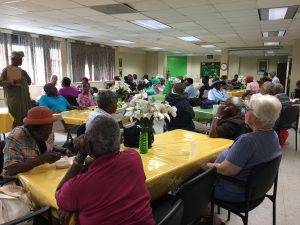
We have been experimenting with making our laughter sessions increasingly interactive. We invited our attendees to suggest ingredients for the stew and it included chicken, pumpkin, onions, carrots, potatoes, and bullion. After we added and stirred, we tasted and it was both delicious and “funny” tasting.
For our milkshake, we first asked people what ice cream they want to use. We had a lot of chocolate lovers. A few enjoyed vanilla and strawberry. We also had fans of praline cream, banana, and cherry Garcia. We held an imaginary container in one hand and we poured milk with the other hand and and said, “Ha ha ha.” After doing that three times, we scooped in our ice cream three times, adding in laughter syllables. Then, with both hands, we shook and laughed. Finally, we tasted and enjoyed a good giggle.
Ron and I continue to explore ways to add more laughter into our every day lives. The benefits of sustained intentional laughter include reducing stress, lowering blood pressure, boosting the immune system, increasing oxygen to the brain, creating a sense of connection and community, and increasing feelings of happiness. Plus, laughter offers us aerobic exercise.
Here are some of the way we’re adding extra laughter into the day:
- Laughing while we exercise. Squats are much more fun when you’re giggling as you do them.
- Adding laughter activities in while we walk.
- Singing “Ha Ha” syllables to favorite tunes. Even a simple, Row Row Row Your Boat, with Ha ha syllables, makes us laugh.
- Looking at the clock and deciding, “We’re going to laugh for one minute.”
We often visit Robert Rivest’s site for short ten-minute laughter videos, which cheer us onward. Laughteryoga.org offers more great resources. And we have fun creating our own laughter activities. If you have laughing ideas you want to share, we’d love to hear from you.
Deborah Shouse is the author of Connecting in the Land of Dementia: Creative Activities to Explore Together and Love in the Land of Dementia: Finding Hope in the Caregiver’s Journey.
Pick the Best Care Community for Your Loved One
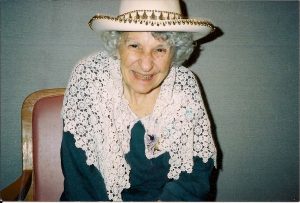
My hands were sweating as Mom, Dad, and I entered the memory care unit. We desperately wanted to pick the best care community for my mother. Pam, the head nurse, rushed towards us, arms outstretched.
“So good to see you again,” she told my father and me. She turned to Mom. “And you must be Frances. Paul has told me so much about you. I hear you’re a nurse too.”
She took Mom’s arm and they walked together down the corridor, talking. We followed and Pam stopped at a small dining area, where coffee and cookies, chocolate chip, one of Mom’s favorites, awaited us. Dad and I looked at each other and smiled. Maybe, just maybe, this was going to be all right.
We had already visited several homes and none of them seemed warm enough, caring enough, or quiet enough for Mom. What had won us over was Pam and her feeling for people who were living with memory loss, her determination to create community, her compassionate and easy way of communicating.
#
One of the most challenging experiences caregivers can face is finding the right community when your loved one needs care. Jytte Lokvig, PhD, regularly consults with families on this issue. Her new book, Moving & More, offers families concrete guidelines for finding the facility that meets their needs.
Click here to see our interview with Jytte Lokvig
When visiting a care community, Jytte suggests that we ignore the lobby and the landscaping. A beautiful lobby soothes the family’s soul but has little to do with the quality of care and engagement offered. Spend at least a couple of hours in memory care.
“Remember,” she says, “you are asking your loved one to live here. Stay on after your tour and blend into the scenery, so you can really get a sense of how staff and residents interact.”
Here’s what you want to learn:
- Does the facility practice “Person centered-care?
- Do residents participate in menu and activity choices?
- What is the staff/resident ratio?
- What are the staff retention rates?
- Do all staff receive mandatory first aid and dementia training?
- Are the family, nurse, personal care and activity staff involved in creating the resident’s care plans?
- Does the activities calendar offer a blend of entertainment and interaction?
- Are there both individual, small group, and large group activities?
- Does the staff acknowledge each resident, even with a simple greeting or compliment?
After you have a sense of the community, take your loved one to visit. Have a meal with the residents. Stay for an activity program.
“Several visits like this helps both of you feel more comfortable when the move comes,” Jytte says.
For more tips and information, visit Jytte’s site at http://www.alzheimersatoz.com and consider her book: Moving and More.
Deborah Shouse is the author of Connecting in the Land of Dementia: Creative Activities to Explore Together and Love in the Land of Dementia: Finding Hope in the Caregiver’s Journey.
Art Invites Conversation
Teri Miller, with the Alzheimer’s Association Houston & Southeast Texas Chapter, has witnessed the power of how art invites conversation. As the Early Stage Program Manager, Teri collaborates with a variety of Houston’s arts and civic organizations.
“Going to cultural activities offers people a sense of normalcy and gives them a date to put on their calendars,” Teri says. “When they go with friends or care partners, they have an experience to discuss. Even people who say, ‘Oh, I don’t care for museums,’ usually have a great time.”
Sam is an example of someone who was surprised to enjoy the art gallery.
He attended one of Teri’s early stage support groups. His wife, who cared for him at home, went to the care partner’s group. Teri formed a partnership with the Houston Museum of Fine Arts and invited her early stage group to experience a tour. When he heard the invitation, Sam rolled his eyes and said, “I’ve never been to a museum and I’m not about to start now.”
But the next week, Sam signed up for the tour.
“What made you change your mind?” Teri asked.
“My wife really wanted to go. She does so much for me, I figured I’d do something for her.”
Teri expected Sam to sit back silently, arms folded over his chest, as the docent asked, “What does this painting make you think of? Has anyone ever been in a similar setting?” But to Teri’s surprise, Sam had opinions on each of the three pieces they discussed.
Sam told Teri, “At first, I didn’t want to go because I was worried I wouldn’t have anything meaningful to contribute. But I guess you don’t have to know anything about art to enjoy the museum.”
He and his wife talked about the experience all the way home. Discussing the paintings opened up chances to reminisce and connect. Plus the experience gave them something interesting to share with their grown children and visiting neighbors.
Like many art partnerships around the country, Teri was inspired by MOMA’s Meet Me art program for people living with dementia. The Houston museum benefitted from MOMA coming to train their docents. The program offers comprehensive guidelines for visiting a museum or viewing art at home.
Creative Sparks:
Many art galleries and museums offer special tours and events for people living with dementia. If you’re lucky enough to have such a tour available, take advantage of it.
To design your own museum tour:
- Think of a museum your partner likes. If feasible, buy postcards of some of their art or visit their on-line gallery together and ask your partner which pieces he prefers. That way, you can tailor the visit to his taste.
- Choose one or two rooms that feature his preferred art. Make sure one room has a place to sit.
- Use the paintings and sculptures as a catalyst for conversation. Ask open-ended questions, discussing the colors, people, and objects you both notice.
- If the museum has a restaurant or tearoom, treat yourselves to something delicious.
- Enjoy the sense of connection that comes from discussing art; there are no right or wrong answers, just interesting observations.
- To fashion a viewing experience at home:
- Select art books from the library or use your own personal collection.
- Choose works that portray emotion, tell a story or align with your partner’s background or interests.
- Ask open-ended questions that invite conversation, such as, “What does this make you think of?” and “What do you notice in this picture?” Have fun imagining what the people in the painting are thinking. Imagine their professions and whether they’re happy.
This is an excerpt from Connecting in the Land of Dementia: Creative Activities to Explore Together. Deborah also wrote Love in the Land of Dementia: Finding Hope in the Caregiver’s Journey.
Share Your Creative Arts Endeavors: An Opportunity for People who are Living with Dementia
I am honored to be part of the Arts Work Group at the Dementia Action Alliance, which is one of my favorite non-profits. Please share this information with those who might benefit. Warmly, Deborah
Dementia Action AllianceDementia Arts Fest 2019
Mike Belleville, 2018
The Dementia Arts Fest celebrates art made by persons living with dementia!
Call for Entries Deadline March 15, 2019
If you are a person living with dementia who engages in creative projects or you’re the leader of a creativity program for people living with dementia, we want to hear from you! You are invited to submit up to 3 pieces of art, ready to display – It’s an easy process to submit. This is what we need:
1. Photos of the artwork in JPEG, PDF, or PNG format. Label each image with your last name, the title.
2. A separate page:
Your name (artist’s name) and contact information.
List of your work with titles, dimensions, and media
3. Write down a brief description about how creating art impacts you and makes you feel. (around 200 words)
5. Email the above information to Karen Love at karenlove4@verizon.net.
Please let us know if you are submitting artwork on behalf of someone else.
Sale of Artwork
▪ Artwork accepted for the exhibition may be for sale, or may be marked as ‘NFS’ (not for sale). If the artwork is NFS, artists must include a prepaid return shipment label for UPS or Federal Express with their artwork shipment.
▪ If the artist’s work is sold, the Dementia Action Alliance [a 501(c)(3) charity] will receive 50% of the retail price set by the artist as a contribution.About the Dementia Action AllianceThe Dementia Action Alliance is a national non-profit organization of people living with dementia, care partners, dementia specialists and others making our nation a better place in which to live with dementia. www.daanow.org
Deborah Shouse is the author of Connecting in the Land of Dementia: Creative Activities to Explore Together and Love in the Land of Dementia: Finding Hope in the Caregiver’s Journey.
KC Memory Cafe: The Goat and Pony Show
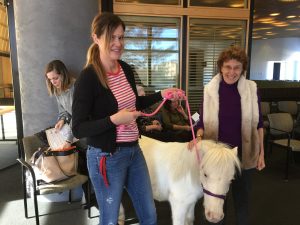 One of the stars of November’s KC Memory Cafe was a miniature horse. It’s not every day that a white horse and a couple of black goats visit the Plaza Library, accompanied by exotic bunnies and silky chickens. But these friendly animals, brought to us by the Paramount Petting Zoo, captivated all our attendees.
One of the stars of November’s KC Memory Cafe was a miniature horse. It’s not every day that a white horse and a couple of black goats visit the Plaza Library, accompanied by exotic bunnies and silky chickens. But these friendly animals, brought to us by the Paramount Petting Zoo, captivated all our attendees.
“These animals love to be held and petted,” their keepers told us. They instantly snuggled into people’s arms and were in no hurry to leave. Our attendees were filled with a magical sense of connection and relaxation, mixed in with the thrill of meeting all these new animals.
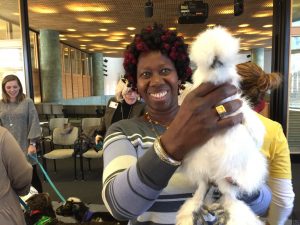 “Animals fill us with excitement, and give us something to talk about,” says Mandy Shoemaker, co-founder of Prairie Elder Care. Mandy’s organization is part of the esteemed Eden Alternative, a national movement dedicated to reducing loneliness, helplessness, and boredom through loving companionship and meaningful engagement.
“Animals fill us with excitement, and give us something to talk about,” says Mandy Shoemaker, co-founder of Prairie Elder Care. Mandy’s organization is part of the esteemed Eden Alternative, a national movement dedicated to reducing loneliness, helplessness, and boredom through loving companionship and meaningful engagement.
“Animals give us a connection,” she says.
We could see and feel that connection as we all enjoyed feeding the goats, petting the horse, and cuddling with the bunnies and the chickens. We also shared farm memories and Mandy asked, “How many of you ever thought you’d be holding a chicken in your lap?”
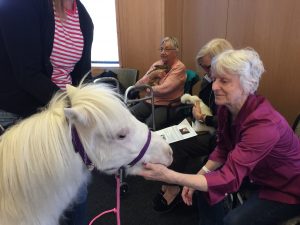 For most, it was a unique experience, one they did not tire of. For some,
For most, it was a unique experience, one they did not tire of. For some,  parting with their loving chicken or bunny was like saying good-bye to a dear friend.
parting with their loving chicken or bunny was like saying good-bye to a dear friend.
To meet the animals, click here.
Deborah Shouse is the author of Connecting in the Land of Dementia: Creative Activities to Explore Together and Love in the Land of Dementia: Finding Hope in the Caregiver’s Journey.
Santa and the Symphony Visit the KC Memory Cafe
 At our December Memory Cafe, Santa had an amazing pre-show- warm-up band: a trio from the Kansas City Symphony. Their renditions of familiar holiday tunes were musical works of art, filled with melodic flourishes and surprises. Our guests listened avidly. When Stephanie Brimhall, the Symphony’s Education Manager, led us in a singalong, everyone raised their voices and sang with heart and gusto. As our attendees finished decorating Christmas cookies with colorful icings, bright sprinkles, and little chunks of peppermint, we heard a jingling of bells and a booming, “Ho Ho Ho.” Santa had arrived, with a sack of treats.
At our December Memory Cafe, Santa had an amazing pre-show- warm-up band: a trio from the Kansas City Symphony. Their renditions of familiar holiday tunes were musical works of art, filled with melodic flourishes and surprises. Our guests listened avidly. When Stephanie Brimhall, the Symphony’s Education Manager, led us in a singalong, everyone raised their voices and sang with heart and gusto. As our attendees finished decorating Christmas cookies with colorful icings, bright sprinkles, and little chunks of peppermint, we heard a jingling of bells and a booming, “Ho Ho Ho.” Santa had arrived, with a sack of treats.
“How many of you have been good?” Santa asked and most of us raised our hands. Santa made the rounds, passing out sweet treats, courtesy of Russell Stover Chocolates, and wishing everyone a merry holiday.  Then he settled into a comfortable chair beside the backdrop of a scenic hearth. We all lined up to sit beside him and have our photos taken with the Great Claus. Santa warmly welcomed each person and everyone was just thrilled to be near him — and even more thrilled when Jennifer Walker’s remarkable little printer produced a wonderful photographic memento of the event.
Then he settled into a comfortable chair beside the backdrop of a scenic hearth. We all lined up to sit beside him and have our photos taken with the Great Claus. Santa warmly welcomed each person and everyone was just thrilled to be near him — and even more thrilled when Jennifer Walker’s remarkable little printer produced a wonderful photographic memento of the event.
At the end, Santa summed up the holiday spirit by sharing this message: “Peace for the world and good will for all people.”
We hope we can all continue this spirit of hope, sharing, and generosity throughout the new year.
Capture the cafe spirit for yourself by clicking on this short video:
Deborah Shouse is the author of Connecting in the Land of Dementia: Creative Activities to Explore Together and Love in the Land of Dementia: Finding Hope in the Caregiver’s Journey.
Santa Takes a Stand
I saw the red outfit and overgrown white beard even before I heard the bell ringing. I reached into my pocket to dig out a few coins. This Sunday Santa looked surprisingly like a Norman Rockwell version. Then I noticed there was a glint rather than a twinkle in his blue eyes.
“I’m asking you to give back,” the man in red said:
“Excuse me?”
“I’m asking you to give back!” His voice was deep, but I didn’t hear the old jolliness.
He handed me a piece of paper with the heading: Capital Campaign, The Season for Giving, S. Claus and Associates. “Have you received good service from our outfit over the years?”
“Well, yes, I have,” I said, remembering the red bicycle that had magically appeared when I was seven.
“And do you feel like we have met and exceeded your expectations?”
“Yes, I do.” I rubbed my hands together. The wind was sharp and my fingers felt frozen.
“I really need to get going,” I said.
Santa touched my arm. “We need your help. How would you feel if you’d been working night and day for others, trying to make wishes and dreams come true, creating astonishing presents and delivering them. How would you feel if all you ever received back was the occasional cookie and milk. I have had enough. I am asking you to give back.”
I looked at Santa carefully and wondered if whoever hired him knew he was over the edge. I breathed in, but detected no odor of alcohol. His pupils were not dilated; his hands not frenetic. He didn’t look like he was on some mind-altering substance.
I reached into my wallet for a dollar or two.
“No,” he said, pushing away the money. “I want you to truly give. Not just a spare couple of bucks. I want you to understand and appreciate what I’m doing.”
Part of my brain was sternly reminding me this was an ordinary man dressed in a fluffy red suit. Then, a wave of compassion pushed through me. Here was a great mythological hero asking for help!
Santa’s legs seemed to buckle and he sagged as though he were about to fall. I took his arm and led him into a nearby fast food place, where I bought him coffee and fries and a big burger with everything. As he ate, I pulled out my cell phone.
“I’m going to be a few minutes late,” I told my shop manager.
“That’s just one of the things we need,” Santa said mournfully, as I finished my call.
“What?”
“Cell phones. Can you imagine dropping down all those chimneys without calling ahead first and making sure there’s no chestnuts roasting?”
I pictured Santa, sitting in his reindeer-driven sleigh, dialing direct and collect. I wondered how many would take the call.
“Santa, people expect to receive from you. That’s what we love about you. All we have to do is act reasonable for a year, and we get wonderful gifts.”
“Things change,” Santa said. “We’ve existed for years on nothing but goodwill and good cheer. But the supply is running low. I’m thinking we should forget the old fashioned approach and embrace the age of technology.”
My throat tightened. I imagined Santa, logging in on line, charging up presents on his gold credit card, filling out W-2’s on the elves and writing up reports for OSHA and the SPCA about the reindeer. I imagined a virtual holiday, where presents simply appeared as part of an email attachment, recipients unspecified.
“What can I do?” I asked. “Do you have a list of what you want? We always give you a list to work from.”
“I hadn’t thought of that! Of course! Can I borrow a crayon and paper?”
I handed Santa a pen and a page from my note pad. As he wrote, I stared out the window, watching shoppers rush past. Most of them looked anxious and overwhelmed. They would be even more anxious if they knew Santa was considering taking a Christmas off!
Santa smiled as he handed back my pen and said,
“Now, I want to sit in your lap and read you my list.”
“What!”
Before I could refuse, Santa had settled at least half of himself on my lap.
“So what would you like for Christmas?” I said, in my deepest, merriest voice.
- “A cell phone, with unlimited long distance.
- A new transportation system. Something that doesn’t leave hoof prints.
- Productivity training for the elves.
- Sensitivity training for the reindeer.
- A new suit, something with pockets.
- A new corporate headquarters — in a more temperate climate.
Santa bounced up and down as he recited his list. Each bounce made my legs twinge. Each word made my heart cringe. If Santa traded his charm, and his bumbling good will for high tech efficiency, the whole spirit of the holiday season would be radically changed.
“Now what?” I asked, when Santa had finished his list..
“Now that you’ve paid some attention to me, I feel better.” Santa stood up. He fluffed his beard, brushed a few crumbs off his belly, and said, “Ho Ho, I feel richer already. Please spread the word about giving back.”
I raced to work, feeling great. I had just given to one of the world’s champion givers. As I walked down the crowded street, I looked carefully at each rushing person, wondering who else was in need of a little good cheer.
Deborah Shouse is the author of Connecting in the Land of Dementia: Creative Activities to Explore Together and Love in the Land of Dementia: Finding Hope in the Caregiver’s Journey.
